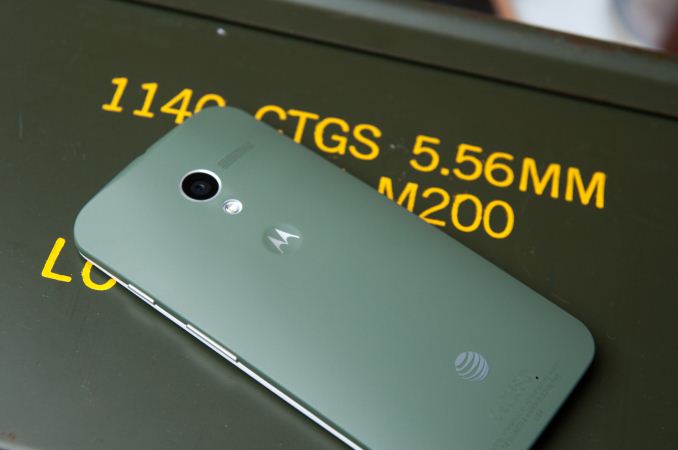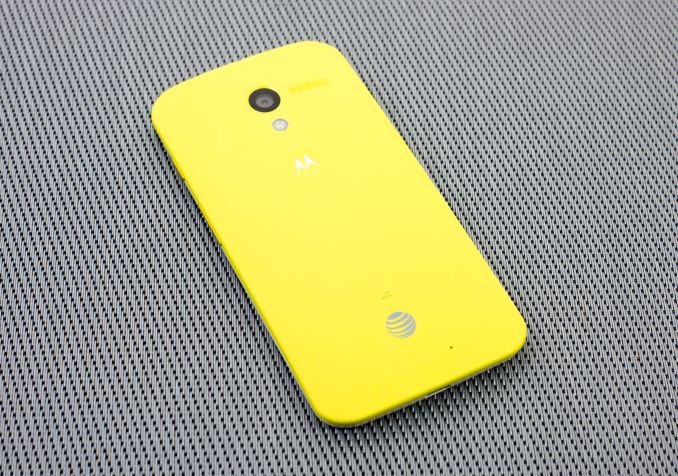Moto X Review
by Brian Klug on August 26, 2013 1:30 PM EST- Posted in
- Smartphones
- Qualcomm
- MSM8960
- Motorola
- Android
- Mobile
- Android 4.2
- Moto X
Moto Maker - A Customized Moto X
A large part of the Moto X story is the ability for users to order their own customized variants with different color combinations and an optional customized engraving (at a later date) and line of text at boot. Initially exclusive to AT&T, the Moto Maker customization tool manifests itself as a web portal where shoppers can select from 18 different back colors, 7 accent colors, and a black or white front at no additional cost. In the future there will be additional patterns and materials available, for example additional textures and the wood materials I touched on earlier later in Q4.
The workflow is simple, either shoppers go online to Moto Maker directly, or (at launch) go into an operator store, see color samples, buy a 16 or 32 GB Moto X Moto Maker pass, and then either complete the Moto Maker customization option on a kiosk at the store or later from the comfort of their home. Motorola then assembles the custom Moto X in Fort Worth, Texas and ships to anywhere in the USA with a 4 day turnaround time. Shoppers who want to walk out of an operator store with a device in hand will have to opt for the woven white or black options as mentioned before.
The initial AT&T exclusivity is disappointing if you’re on one of the four other major wireless operators in the USA, however I expect the other operators to get brought in immediately after the exclusivity period ends, but there’s no word how long that is for AT&T. The Moto Maker part of the customization experience is also exclusive to the USA given the four day window Motorola is shooting for, so that means Canada, Latin America, and other markets get left out.
Motorola gave us a chance to play with Moto Maker before the Moto X launch and order a customized Moto X of our making just to try it out. I settled on a combination of olive back, white front, and silver accent color, plus the customized line of text on the back, for an overall somewhat tactical look (the "olive color" winds up being like a lighter olive drab, it’d be cool if Motorola had flat dark earth available). Anand went with a completely yellow lemon colored unit that looks very striking. The tool works very well and presents a 360 degree view of the device as you step through the process, it’s all very compelling, even if choosing a combination from the wealth of back colors and accents is somewhat daunting. I went through about 5 different permutations of Moto X colors before settling on the one I finally pulled the trigger on.
Motorola didn't exactly nail the 4-day delivery window for either Anand's or my own customized Moto X, and my back didn't get the customized line of text on it, although Anand's did. Mine ended up taking a little over a week to get delivered, but a large part of that was because they essentially built two Moto Xes in that timeframe due to the engraving issues they discovered. I'm willing to acknowledge that this first set of customized Moto Xes we were given the opportunity to order were technically during a "Beta" release of the Moto Maker, so hopefully kinks like the customized line of text not being present and the turnaround time are sorted out quickly.
Anand's customized Moto X looks great in pictures, and I'm pleased with the way mine came out as well. It definitely adds something to the experience to be able to choose out your own color combination.
The customization options are great for users who want to differentiate their devices from the uniform black or white squares that are pretty standard fare these days, and I expect the Moto Maker route to be a popular option given how loud Motorola will be about the customization aspect of the Moto X. After all, at no additional cost (unless you go for wood, more storage, the optional matching headphone accessories or a case) there’s really no reason you shouldn’t go for something custom or unique looking.
For some, the Moto Maker tool is probably enough to sell the device on its own, but customization options only go so far towards closing a sale. What Motorola has done however by offering an easy to use tool and quick turnaround is both awesome and unprecedented.
























105 Comments
View All Comments
SomeGuyonaBike - Tuesday, August 27, 2013 - link
I understand and agree with general objections to carrier-installed bloatware (and because of this I won't decide whether or not to buy a carrier-branded X until details about the developer editions are public)... I'm just curious as to why reviewers are so negative about this particular piece of carrier bloat.Impulses - Tuesday, August 27, 2013 - link
I think I disabled it on my sister's One X, wasn't really an issue...SomeGuyonaBike - Tuesday, August 27, 2013 - link
I spent a few minutes playing with a demo unit at an AT&T store over the weekend. When I launched the "People" app it wanted to sync to an AT&T address book, but there was an option to decline. I wonder if opting out of using the AT&T address book is a permanent thing, or if you have to repeat the opt-out every so often.Tralio - Wednesday, September 11, 2013 - link
AT&T address book is a bit of an annoyance for everyday use, even on the X it tends to open incredibly slow. On the other hand when switching to my X it imported all my contacts onto my device without needing to import from sim. This can be an issue when switching from some of motorola or other developers' older models with larger sims, especially with the X not having an sd card slot and not every user knowing they can import/export from their comp. On a side note though for at&t users (not sure about the rest of the carriers) all at&t stores have a sim cutter that they can cut your sim down to the smaller size if you'd prefer to import from your current sim card or just don't want to deal with activating the new one.jasperjones - Monday, August 26, 2013 - link
Brian,I agree that smartphone line out/headphone out sound quality is still a bit of a challenge. Looking forward to your new audio test suite. It would be great if you guys could report RMAA results.
Brian Klug - Monday, August 26, 2013 - link
I like RMAA, but it's easy to get a lot of things wrong and isn't really mobile workflow friendly. We're going to try something different that's a lot more robust :)-Brian
synaesthetic - Friday, September 6, 2013 - link
The thing I would like most, that I can't seem to find anywhere for any smartphone, and something that affects audio quality with headphones to a greater degree than any other attribute...Output impedance.
Please, for the love of all that is holy, why can't at least one device reviewer measure the output impedance of these phones?!
cheinonen - Monday, August 26, 2013 - link
I should find out this week if I'll have access to a new suite of tests or not. If I can do it, RMAA will look like child's play in comparison. Believe me, we're looking forward to it.Impulses - Tuesday, August 27, 2013 - link
Are you gonna go back and test at least this year's flagships? It'd be nice to have a baseline, particularly since this is something manufacturers have supposedly emphasized (HTC with the One, LG with the upcoming G2).cheinonen - Tuesday, August 27, 2013 - link
It looks like I'll have access to some new testing methods, but it will be a month or so until I can do them all probably (sorry, I have a large backlog of other things to get done right now). I'll plan to do a huge initial round-up of phones and tablets to get a baseline and create an article about the new tests. I also want to point out that audio tests might not run with the initial phone tests since Brian or anyone else will have to ship the phones to me in Oregon to test and it'll take them out of the hands for a few days.We haven't tested this yet, but we're hoping it really helps us set a standard for audio testing of phones and tablets.